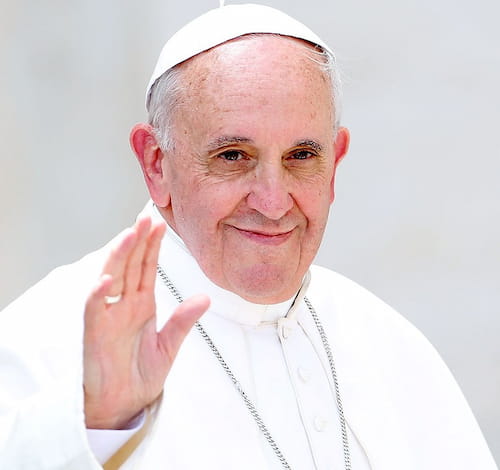Pope Francis Biography: The Life, Legacy, and Impact of a Transformational Pontiff
Introduction

Pope Francis, born Jorge Mario Bergoglio on December 17, 1936, in Buenos Aires, Argentina, became a defining figure of the 21st-century Catholic Church. His historic election as the first Latin American pope, the first Jesuit to assume the role, and the first to take the name Francis marked a major shift in tone and vision for the Vatican. From the moment he appeared on the balcony of St. Peter’s Basilica in March 2013, it became clear that his papacy would break with many traditions. With his humility, dedication to social justice, and insistence on compassion over dogma, he invited the world to rethink what it means to lead with faith.
Pope Francis Personal Background
Pope Francis was born into a modest household in Buenos Aires, Argentina, to Mario Bergoglio, a railway worker from Italy, and Regina María Sívori, a stay-at-home mother. His family was of Italian immigrant origin, and they lived in a working-class neighborhood. His early life showed a strong sense of faith, shaped by the everyday struggles of his family.
At the age of 21, Pope Francis faced a significant health challenge when he suffered from a severe lung infection, which led to the partial removal of one of his lungs. This event deeply impacted him and nurtured his empathetic nature, which would later influence his approach to leadership in the Church.
As the oldest of five siblings, he had a significant role in his family, which also consisted of his younger brother Alberto, and sisters Mónica, Oscar, and Maria Elena. The influence of his family—particularly his father’s strong work ethic and his mother’s compassion—shaped the core values that Pope Francis would carry throughout his life. The values of humility, service, and empathy would later become central to his papacy.
Pope Francis’ Family
Pope Francis was born into a close-knit family with deep Italian immigrant roots. His father, Mario Bergoglio, worked as a railway worker after emigrating from Italy, and his mother, Regina María Sívori, stayed at home to raise their five children. His parents instilled in him strong Catholic values, an appreciation for humility, and a profound sense of service to others. The Bergoglio family lived modestly in Buenos Aires, and these early experiences would shape Jorge’s later vision of Church leadership.
Pope Francis was the oldest child of the family. He had four younger siblings: Alberto, Mónica, Oscar, and Maria Elena. Growing up as the eldest, Jorge took on responsibilities early, which likely nurtured his sense of leadership. Despite his future as the leader of the global Catholic Church, he did not experience privilege in his childhood. Instead, he shared the experiences of many working-class families in Argentina, which grounded him in the realities of everyday life and suffering.
The influence of his family was profound. His father’s work ethic and his mother’s compassion taught him important lessons about serving the community. These values would be a cornerstone of his later papacy, where he consistently advocated for the poor and marginalized. Throughout his life, Pope Francis maintained close relationships with his family, even during his time in the Vatican. His siblings, particularly his younger brother Alberto, were known to maintain a strong connection with him, and they continued to live in Buenos Aires.
In addition to his immediate family, Pope Francis was deeply influenced by his Italian heritage, which helped him maintain a strong cultural identity. His family’s story of immigration and adaptation to Argentine society mirrored the journeys of countless others, influencing his compassionate stance on migration and refugee rights later in life.
Pope Francis Age
At the time of his death on April 21, 2025, Pope Francis was 88 years old. Throughout his life, he demonstrated remarkable resilience in facing numerous health challenges. In his final years, Pope Francis struggled with respiratory issues and mobility limitations. Despite these challenges, he remained active until shortly before his passing, continuing to lead the Church and speak on global issues. His death marked the conclusion of a transformative era in the Church, which was defined by his personal humility and deep commitment to the global community.
Pope Francis Education
Pope Francis’s educational journey was deeply rooted in both academics and spirituality, which shaped his leadership and approach as a religious figure. Before entering the seminary, Jorge Mario Bergoglio was not only a dedicated student but also someone who showed a strong aptitude for science and critical thinking.
He attended technical school in Buenos Aires, where he earned a chemical technician’s diploma, which laid the foundation for his analytical skills. After completing his high school studies, he briefly enrolled at the University of Buenos Aires, studying to become a chemist. However, his sense of spiritual calling soon led him away from a career in science and toward the priesthood.
In 1958, Bergoglio entered the Society of Jesus (the Jesuits), a religious order known for its intellectual rigor, commitment to education, and missionary work. His academic journey continued at the Colegio Máximo de San José in San Miguel, where he studied humanities and philosophy. After completing his philosophical studies, he went on to pursue theology, earning a licentiate in theology.
Bergoglio’s time as both a student and later as a teacher further shaped his spiritual and intellectual outlook. He taught literature and psychology at various Jesuit institutions in Argentina, all the while growing in his commitment to the Jesuit values of service, education, and social justice. His education, particularly in philosophy and theology, laid the foundation for his later focus on dialogue, intellectual inquiry, and pastoral care—principles that would define his papacy.
Pope Francis Early Life and Religious Calling
Jorge Mario Bergoglio was born on December 17, 1936, in Buenos Aires, Argentina, into a working-class family of Italian immigrants. His father, Mario, worked as a railway accountant, while his mother, Regina, stayed at home to care for their five children. From an early age, Jorge was shaped by values of humility, hard work, and faith.
Before entering religious life, Bergoglio pursued higher education. He earned a chemical technician’s diploma from a technical secondary school, which gave him a solid grounding in science and critical thinking. He later enrolled at the University of Buenos Aires, where he studied briefly before deciding to enter the seminary. His interest in learning and reflection remained strong throughout his life.
In 1958, Bergoglio entered the Society of Jesus, a religious order known for its commitment to education, intellectual pursuit, and service to the poor. He undertook rigorous theological and philosophical training, studying humanities in Chile and later earning a licentiate in philosophy from the Colegio Máximo de San José in San Miguel. He went on to teach literature and psychology at Jesuit institutions before completing his theology licentiate, also in San Miguel.
This academic and spiritual formation deeply influenced his leadership style. His Jesuit background instilled a lifelong commitment to discernment, reflection, and a preference for action rooted in deep contemplation. His time as both student and teacher made him especially attentive to the importance of dialogue, education, and listening—principles that would guide his papacy decades later.
Pope Francis Rise Through the Church
By the late 1990s, Bergoglio’s humility and pastoral approach earned him a reputation as a servant leader. In 1998, he became Archbishop of Buenos Aires. He stood out not just for his theological insights but for his lifestyle. While other bishops resided in opulent quarters, he chose to live in a small apartment, cook his own meals, and commute by bus. These actions reflected not just personal values but a broader vision for a Church that serves rather than rules.
In 2001, Pope John Paul II elevated Bergoglio to the College of Cardinals. Even then, he remained deeply rooted in the lives of ordinary people. He rarely traveled and avoided the Vatican spotlight. Yet within Church circles, he was increasingly recognized as a voice for the voiceless—a man committed to reform, inclusivity, and spiritual authenticity. When Pope Benedict XVI resigned in 2013, the conclave saw Bergoglio as someone capable of leading a wounded Church with strength and compassion.
Pope Francis Election as Pope
On March 13, 2013, Jorge Mario Bergoglio was elected the 266th pope of the Roman Catholic Church. He chose the name Francis, inspired by Saint Francis of Assisi, a figure revered for his love of peace, nature, and the poor. That choice alone signaled a departure from tradition. It announced to the world that this papacy would not be one of pomp and rigidity, but of service and
simplicity.
Papacy and Global Leadership
As pope, Francis consistently emphasized core Christian values such as mercy, humility, and solidarity with the marginalized. He rejected the trappings of power, choosing modest garments and refusing to live in the Apostolic Palace. Instead, he took up residence in Casa Santa Marta, a guesthouse within the Vatican, and continued to preach directly to those most in need of hope and healing.
Pope Francis Environmental Advocacy and Laudato si’
One of the most defining aspects of Francis’s papacy was his deep concern for the environment. In 2015, he released the groundbreaking encyclical Laudato si’, in which he called for urgent global action on climate change. This document framed environmental protection as a moral imperative and made headlines around the world. For the first time, a pope firmly placed ecological crisis within the context of faith and responsibility to future generations.
Pope Francis Church Reforms and Inclusion
Throughout his tenure, Pope Francis also called for sweeping reforms within the Church. He worked to increase transparency in Vatican finances, restructured departments, and appointed a more diverse group of cardinals—including many from Africa, Asia, and Latin America. His emphasis on global representation helped reshape the Catholic Church as a more inclusive and culturally diverse institution.
Pope Francis never shied away from controversial topics. He urged the Church to take a more compassionate stance toward divorced and remarried Catholics. He welcomed LGBTQ+ individuals with empathy, famously saying, “Who am I to judge?” He also called for greater roles for women in Church life, though he stopped short of supporting women’s ordination to the priesthood. While he faced criticism from both traditionalists and progressives, his focus remained on building bridges, not walls.
Pope Francis International Diplomacy and Moral Voice
Internationally, Francis acted as a powerful diplomatic figure. He played a key role in helping restore relations between Cuba and the United States, promoted interfaith dialogue with Muslim, Jewish, and Eastern Orthodox leaders, and often visited regions affected by war, poverty, and migration. His presence in refugee camps
Pope Francis Burial
Following Pope Francis’s death on April 21, 2025, the Vatican began preparations for his funeral and burial. As with previous popes, his funeral took place in St. Peter’s Basilica. His body was displayed for public viewing in the Vatican’s Apostolic Palace, where thousands of mourners came to pay their respects.
The funeral was a simple, yet poignant affair, reflecting the pope’s own values. There was no lavish ceremony, in keeping with the modesty and humility that marked his life. Pope Francis was laid to rest in the Vatican Grottoes, beneath St. Peter’s Basilica, where many previous popes are buried. His tomb is situated near the remains of other notable popes, including St. John Paul II, whose canonization was one of Francis’s significant papal acts.
Pope Francis’s burial marked the conclusion of an era of profound change in the Catholic Church, and his legacy of humility, compassion, and social justice will continue to inspire millions of people around the world.
